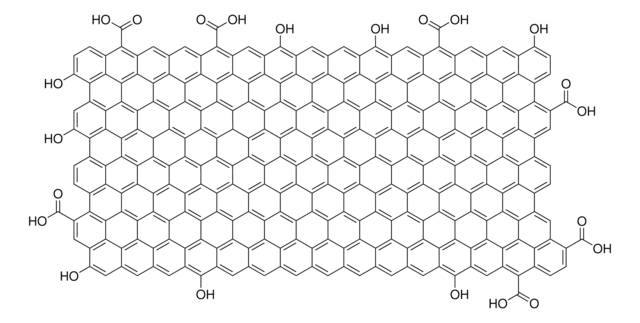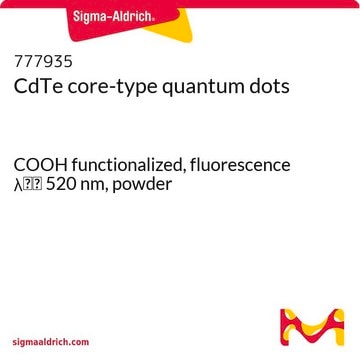Products may be shipped at a different temperature than the recommended long-term storage temperature. If the product quality is sensitive to short-term exposure to conditions other than the recommended long-term storage, it will be shipped on wet or dry-ice. If the product quality is NOT affected by short-term exposure to conditions other than the recommended long-term storage, it will be shipped at ambient temperature. As shipping routes are configured for minimum transit times, shipping at ambient temperature helps control shipping costs for our customers. For more information, please refer to the Storage and Transport Conditions document: https://www.sigmaaldrich.com/deepweb/assets/sigmaaldrich/marketing/global/documents/316/622/storage-transport-conditions-mk.pdf
推荐产品
描述
Expansion Ratio (X:1): 270 to 325
质量水平
表单
flakes
粒径
+50 mesh (>300μ, ≥75% minimum)
pH值(酸碱度)
5-10
溶解性
water: insoluble
一般描述
如果暴露在快速升高的温度下,这些插层化合物会分解成气态产物,这导致石墨烯层间压力较高。这种压力产生的力足以使石墨基面沿“c”轴方向分离。结果是石墨的体积增加了 300 倍,体积密度降低,表面区域增加了约 10 倍。
应用
- 石墨烯前体。
- 碳的无机来源。
- 填充物。
- 热添加剂。
- 阻燃添加剂。
- 铸造粉末。
- 塑料添加剂。
- 橡胶添加剂。
- EMF 吸收体。
- 研磨和筛分。
- 批量装载、卸载。
- 垫圈和密封件的基础材料。
- 涂层。
警示用语:
Warning
危险声明
预防措施声明
危险分类
STOT RE 2 Inhalation
靶器官
Lungs
储存分类代码
13 - Non Combustible Solids
WGK
WGK 1
闪点(°F)
Not applicable
闪点(°C)
Not applicable
其他客户在看
-
How is shipping temperature determined? And how is it related to the product storage temperature?
1 answer-
Helpful?
-
-
How can I determine the shelf life / expiration / retest date of this product?
1 answer-
If this product has an expiration or retest date, it will be shown on the Certificate of Analysis (COA, CofA). If there is no retest or expiration date listed on the product's COA, we do not have suitable stability data to determine a shelf life. For these products, the only date on the COA will be the release date; a retest, expiration, or use-by-date will not be displayed.
For all products, we recommend handling per defined conditions as printed in our product literature and website product descriptions. We recommend that products should be routinely inspected by customers to ensure they perform as expected.
For products without retest or expiration dates, our standard warranty of 1 year from the date of shipment is applicable.
For more information, please refer to the Product Dating Information document: https://www.sigmaaldrich.com/deepweb/assets/sigmaaldrich/marketing/global/documents/449/386/product-dating-information-mk.pdfHelpful?
-
-
Can you tell me the specific surface area and pore volume of this product expandable graphite, available on your website ?
1 answer-
The surface area and pore size are not determined for this product.
Helpful?
-
-
What is the size of 808121 Sigma-Aldrich Expandable Graphite product?
1 answer-
This particle size specification for this product is a minimum of 75% at +50 mesh / 300 um or larger, with the remainder being less than 250 um. The value is lot specific and reported on the product Certificate of analysis. Please see the link below to review a sample or lot specific Certificate:
https://www.sigmaaldrich.com/product/aldrich/808121#product-documentationHelpful?
-
-
Has the graphite (808121) already undergone expansion through a heating process, or is it necessary to expand the graphite by heating? If heating is required, what kind of heating process should be used?
1 answer-
The material in question is considered either Expandable Graphite or Intercalated Graphite. It is sold in its flake form and has not been expanded into worms, which is the industry standard verbiage for expanded graphite.
There are various methods available for the expansion of this material, but certain questions need to be addressed before providing the most suitable approach. For instance, 1 gram of this material will expand to 270 – 325 ml in volume, and the rate and volume of expansion depend on the change in temperature, also known as the “Delta T”. The material will achieve its maximum expansion with a fast thermal shock.
The most widely used method for small quantities involves placing a small amount of material on a piece of Graphite Foil and putting that foil in a furnace heated to at least 950°C (about 1750°F). The higher the temperature, the better. Once the expansion visibly stops, the material should be removed from the furnace and allowed to cool. It is important to note that leaving the material in the furnace for an extended period increases the risk of starting an oxidation reaction. However, this procedure releases acidic gases and should only be performed under a fume hood.
There have been reports of people expanding this material in a microwave, although this method is often incomplete and may result in unexpanded pieces in the product.
If a large amount (production size amounts) needs to be expanded, the use of a larger furnace and some form of air scrubber, typically some type of caustic soda, is necessary to neutralize the off gas.Helpful?
-
-
How long do you need to heat the expandable graphite at the onset expansion temp? Is there a disadvantage to heating it for a long period?
1 answer-
The most widely used method for small quantities is placing a small amount of material on a piece of graphite foil and putting that foil in a furnace heated to at least 950 C (about 1750 F). The higher the temperature the better.
Once you visibly see the expansion stop, pull that material out of the furnace and allow to cool. There is no specific amount of time recommended. The longer you leave this material in the furnace the better chance you have of starting an oxidation reaction. Be aware, that this procedure causes acidic gasses to be released and advised to only be performed under a fume hood.Helpful?
-
-
What is the onset expansion temperature of this product
1 answer-
The most widely used method to check expansion for a small amount of 808121 is placing it on a piece of Graphite Foil and putting that foil in a furnace heated to at least 950 °C (about 1750 °F). The higher the temperature the better. So the onset expansion temp could be 950 °C.
Helpful?
-
Active Filters
我们的科学家团队拥有各种研究领域经验,包括生命科学、材料科学、化学合成、色谱、分析及许多其他领域.
联系客户支持








